Released in 2016, the Sony a6500 has been used by many photographers and filmmakers for the past three years, including me.
As we approach 2020, I wanted to review this camera and explain why, four years after its release, the Sony a6500 is still a great option for independent filmmakers looking for a mirrorless camera.
For personal projects, I have been shooting with the Sony a6500 for the past year and a half, and this camera continues to meet and surpass my expectations.
For its relatively affordable price, the Sony a6500 provides many essential features for filmmakers, such as 5-axis stabilization and 4K video.
When choosing a camera, certain specifications will match filmmakers’ requirements more than others. For example, much of what I do is documentary in nature.
Often, I find myself traveling and frequently shooting in an uncontrolled setting or outside. This makes a small, compact, and durable camera a perfect match.
The slow-motion is 60p with a shutter speed of 1/125, slowed down by 40 percent. The rest is 24p with a shutter speed of 1/50. These shots were done on the Sony E PZ 18-105mm lens. This project certainly tested the limits of the Sony a6500.
I followed the band through practice spaces and venues, unable to bring a gimbal or tripod.
Everything is handheld, and it certainly shows. However, the slow-motion footage is very usable. Additionally, plenty of dancing made it nearly impossible to hold the camera still, so the image stabilization was put to the test.
The settings were also extremely dark, with the ISO being pushed to 8000 at times. Though noisy, the low light capabilities of this camera are still quite good.
A final note is that for the performance, I used autofocus. This made it so I could hold the camera above my head and only need one hand. The camera performed flawlessly.
Though small, the Sony a6500 packs a lot of power into its body.
Whereas I shoot using the picture profile Cine2, requiring minimal color grading, the S-Log2 and S-Log3 profiles give you a much flatter image and greater dynamic range.
I will explain picture profiles in much more detail later in the article, but for now, it is important to know that creating a cinematic look with this camera is possible.
Matching this camera with cine lenses, good audio, and an external stabilization method will let you capture professional footage, making the a6500 useable in low-budget narrative situations and documentaries.
For the independent filmmaker, the Sony a6500 is a reliable and versatile camera, and it has served me well for the past year and a half.
Lightweight, Weather-proof, and Durable Body
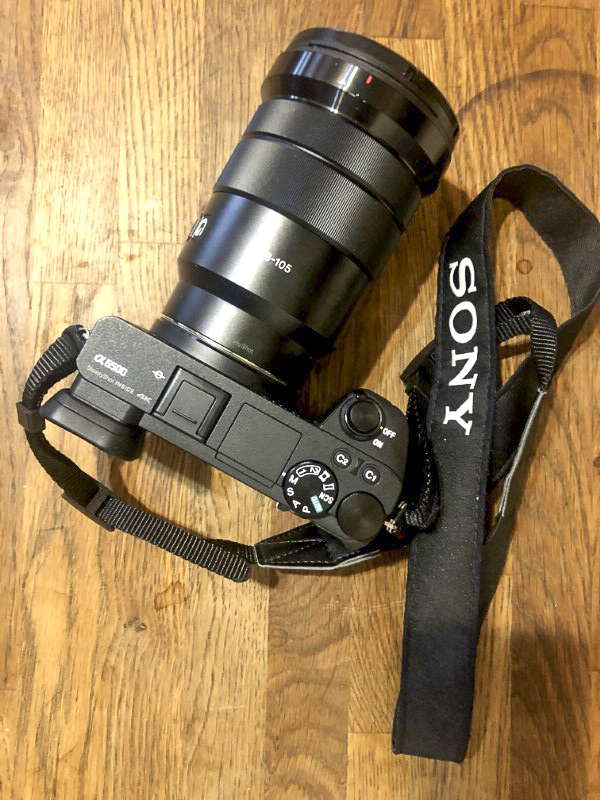
The physical body of the Sony a6500 is compact, water and dustproof, and sturdy, making it a great camera to travel with and use outside.
The camera is light enough to be carried around, though its metal construction (magnesium alloy) makes it durable. The body weighs 453 grams and measures only 120.0 x 66.9 x 53.3mm.
Furthermore, pairing this camera with a small piece of glass like the Sony E PZ 16-50mm lens will give you an extremely compact and portable setup, making guerilla-style filmmaking possible.
As with any camera, external stabilization methods should be used when possible. However, the internal 5-axis gimbal makes run-and-gun filmmaking feasible.
Pulling the camera strap tight around my neck or cradling the camera against my body have both been options when I didn’t have access to a tripod and provided me with a usable image.
The articulating screen is beneficial in these situations, even though it “only” has 180 degrees of motion.
Ergonomically, the Sony a6500 is a comfortable camera to hold for the most part. It is a small body, so you don’t have much to hold onto. However, I find the rubber grip to fit my hand well.
If you’re using a large lens, such as the Sony E PZ 18-105mm, the low relative weight of the body will make it feel front-heavy.
The battery included with the a6500 is an NP-FW50 Li-Ion battery. I would strongly suggest acquiring a couple of extra batteries, especially if you are shooting 4k video.
Though Sony claims 105 minutes of continuous shooting, I’ve found that figure inflated. When you keep the camera on during set-ups and use it to playback and check your footage, you won’t get 105 minutes of continuous shooting.
Something to remember with the Sony a6500 is that it uses an APS-C sensor and has a Sony E-Mount for its lenses. Therefore, if you acquire native full-frame lenses, there will be a 1.5x crop factor.
For example, a 50mm full-frame lens will appear as a 75mm equivalent focal length. This can make finding ultra-wide-angle lenses a little more difficult.
Key Features of the Sony A6500
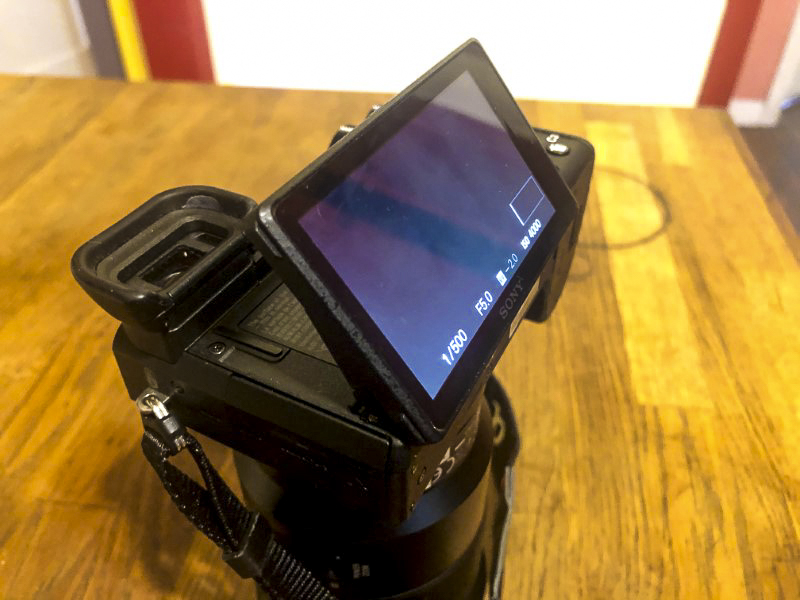
Though I touched on some of the physical features of the Sony a6500, as well as briefly describing the sensor and picture profiles, I want to elaborate on the most useful features of this camera for videographers and filmmakers. This includes the sensor, the ISO range, picture profiles, and focus settings.
24 MP APS-C CMOS Sensor
The sensor in the a6500 is a 24-megapixel APS-C CMOS image sensor. This provides high levels of detail when taking still images, and the camera can record UHD 4k (3,840×2,160) at 24/25/30p. However, when recording at 30p, there is a 1.23x crop factor in 4k.
The XAVC S codec allows UHD 4k recording at 24/25/30p and Full HD recording at 24/30/60/120p. It is also possible to record in AVCHD and MP4 formats, though not in 4k.
Often, 4k is not essential if you export to online formats at 1920×1080. However, recording 4k is extremely helpful if you want to crop in during your editing without losing image quality or if you want to stabilize footage in post.
If you’re only using a single camera, cutting in can allow for a little more leeway, let you hide jump cuts, and give the illusion of multiple angles.
I’ve experienced some issues when recording 4k footage with the Sony a6500. The camera can begin to overheat if you’re doing a long take in a warm environment. If this happens, the screen will dim to limit battery usage or stop recording altogether.
I’ve also found more rolling shutter when panning while recording in 4k compared to Full HD.
Typically, I will film in FullHD. However, if I do an interview and the camera is locked down, I will record in 4k to crop in and add camera movements in post. This is especially helpful if you are working as a crew of one.
Awesome 5-Axis Image Stabilization
Five-axis stabilization is one of the most helpful features of the Sony 6500 for shooting video. This allows the image sensor to shift in five directions, helps combat camera shaking, and is extremely helpful when shooting handheld.
Like I said before, the form factor of this camera is one of its strengths, allowing you to do a lot with a small body. However, the lightweight camera also means that shaking hands will be more apparent.
Luckily, this stabilization helps combat that, and capturing some very smooth shots while shooting handheld is possible.
If the stabilization is paired with image stabilization built into the lens, shooting handheld can be a viable option even at normal and telephoto lengths (if you have a steady hand).
That being said, don’t expect miracles. This stabilizer isn’t a gimbal but rather a nice piece of mechanics used to reduce micro-jitters.
Even if you are using a gimbal or Steadicam stabilizer, built-in stabilization is hugely beneficial and can reduce issues such as wind interference. As independent filmmakers, we often have to cut a few corners, and having a stabilizer to bolster our stabilization methods is a lifesaver.
Highly Usable ISO Range For Low-Light Filming
The Sony a6500 has an ISO Range of 100-25,600 and can be boosted to 51,200. However, much of that range is hardly useable. Up to about 6,400, the image stays clean. However, once you hit 8,000 and above, there will be some apparent noise.
Being able to shoot with an ISO of 6,400 allows you to capture video in some pretty dark situations, and being able to boost that is nice in a pinch.
It’s good to know that in nearly all situations, I will be able to collect footage of some kind, yet it is important to pay attention to the time of day and lighting conditions. Don’t expect miracles to happen; this camera cannot see in the dark, but it certainly holds its own.
The camera also has Auto ISO, which can sometimes be helpful, though certainly not always. Under this setting, you can set an ISO Maximum and Minimum to prevent drastic changes.
I would strongly suggest manual settings if you’re in a controlled setting, such as a narrative shoot. Setting these parameters in less stable environments where things are changing quickly can greatly help prevent you from messing around with camera settings instead of getting the shot.
Picture Profiles
When you first start using your a6500, you will inevitably want to change some picture profile settings if you use it primarily for video. Luckily, there are some great options built into the camera.
The Picture Profile system has nine presets (PP1-PP9), though all are customizable. Many of the presets are usable, and the best way to discover what you like is through doing your tests.
Four of the most talked-about presets for filmmakers are Cine2, Cine4, S-Log2, and S-Log3.
S-Log2 and S-Log3

The LOG profiles S-Log2 and S-Log3 will yield a flat and neutral image. This gives them the most dynamic range and options when color grading.
Between the S-Log2 and S-Log3, there are minimal differences that are also affected by the Gamma, or color range, you pair with it.

S-Gamut.cine matched with S-Log3 is easier to grade than S-Log2/S-Gamut if using LUTs.
However, S-Log2 has more contrast and can be easier to work with without using LUTs in your camera. Overall, these differences ultimately fall to preference.
Cine2 and Cine4

The Cine2 and Cine4 picture profiles are also commonly used in video settings, and these profiles are not as flat as the S-Log profiles but are very easy to work with in post.
I typically shoot using Cine2 and find that increasing vibrancy and saturation, then adding an s-curve to contrast, is almost all I need to do if my white balance is set and I exposed properly.
Cine2 does a good job of retaining most of the information in a shot while still being easy to grade.
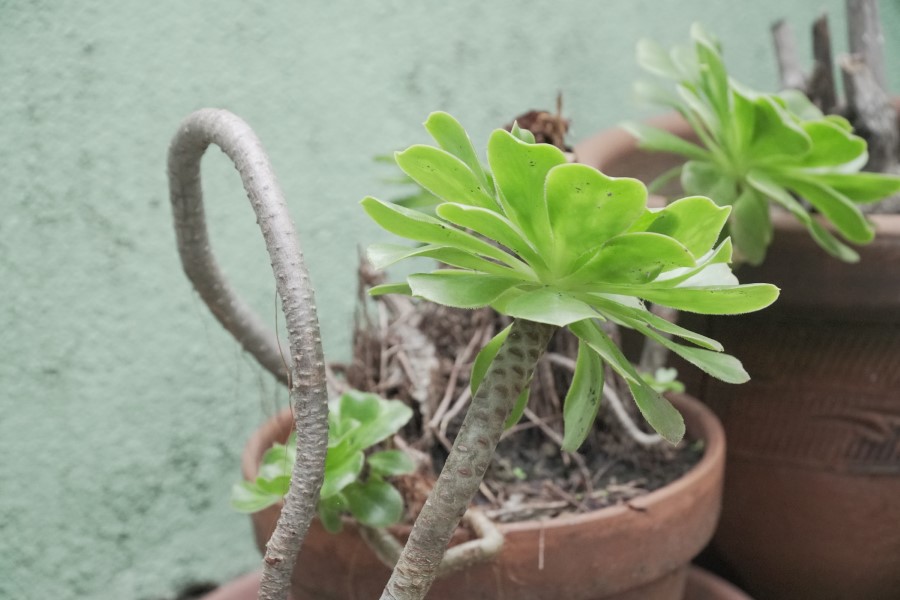
Cine4 also produces an interesting and natural look. However, I find that the images in Cine4 tend to have a bit more contrast. The flatter image of Cine2 allows for a bit more adjustment in post.
Focus Settings
For filmmakers, the Sony a6500 has plenty of different focus modes. Depending on the lenses your using, you may not be able to use the autofocus settings. Frequently manual focus is the best option for filmmaking yet understanding the options available to you is important.
When shooting video, the camera offers continuous autofocus, subject-tracking, and manual focus.
The continuous focus can be helpful if you cannot hold focus manually. However, switching between subjects it can often take a couple of seconds to adjust and look quite unnatural.
In the settings, you can adjust the drive speed between fast, medium, and slow which can help create a smoother transition. Being able to change the speed is nice and can help give a little more control.
Another method of focusing is the tap to focus control on the touchscreen. This is another useful option in a pinch and allows a bit more control over the camera if using autofocus. That being said, I find the autofocus quite finicky and unreliable.
It is also possible to turn face detection on and register faces to the camera. This is quite helpful and can be useful in situations where you are interviewing a moving subject or if you have to film yourself.
Video Features and Display Options
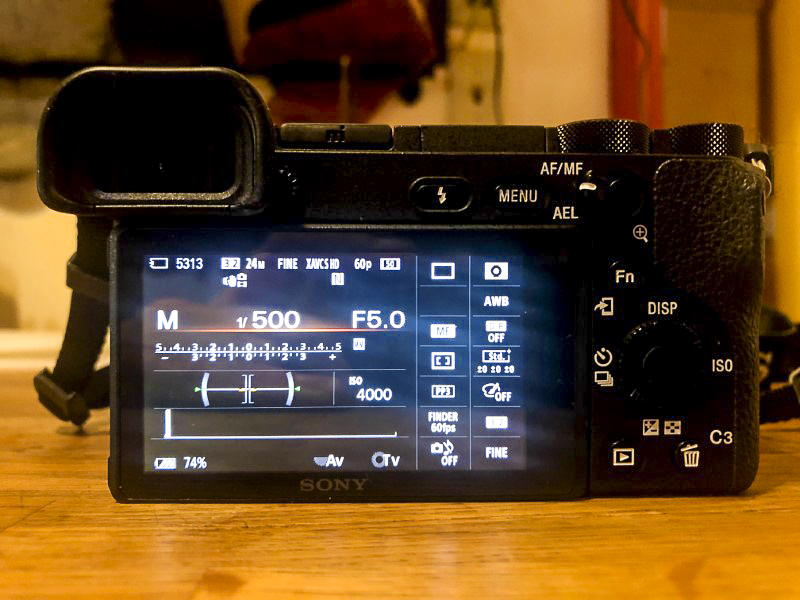
The Sony a6500 has some display options that are extremely helpful in shooting video. These include a level, histogram, focus peaking, and zebra warnings for exposure. These are located in the menu and are great to use if you don’t have an external monitor.
You can turn on focus peaking to assist you if you’re shooting with manual focus. Considering the small screen, this is hugely helpful if you don’t have a monitor. Focus peaking also comes in handy if you’re not using a follow focus and have no way of recording focal lengths but still want to do things such as a rack focus.
Another useful display tool is the zebra warnings when setting exposure. These warnings tell you if a part of your image is blown out and which part of the image that is. I find that this is very useful when shooting outside, especially on a bright day.
Sometimes, especially outside, an image will have too much contrast to capture everything. The zebra warnings can let you see exactly what information you will miss.
You can also pull up a histogram of the shot to show exposure levels. Pairing this with the zebra warnings can help you retain the maximum amount of information. You can see what blacks are being crushed and what part of the image is being blown out.
The histogram is an extremely helpful tool and one of the display options I always have pulled up when setting up my shot. Shooting in Cine2, I tend to want my image slightly overexposed if possible. Seeing the layout of the histogram makes this possible.
The same goes if you’re shooting LOG-footage. Here it’s always wise to expose-to-the-right (ETTR) to avoid to much noise in the shadows.
The other display option I look at frequently is the level. A sensor in the camera lets you see if your image is tilted left/right and up/down. If you’re using a portable tripod such as a JOBY GorillaPod, having this sensor in the camera is instrumental in getting a level shot.
Even in shooting handheld, seeing if the camera is level is huge. On such a small display it is often extremely difficult to notice that we are tilting the camera. Only in editing do we realize the mistakes we’ve made. Having the level, as well as focus peaking, zebra warnings, and a histogram, allows you to correct your mistakes before they happen.
Buttons, and Menus
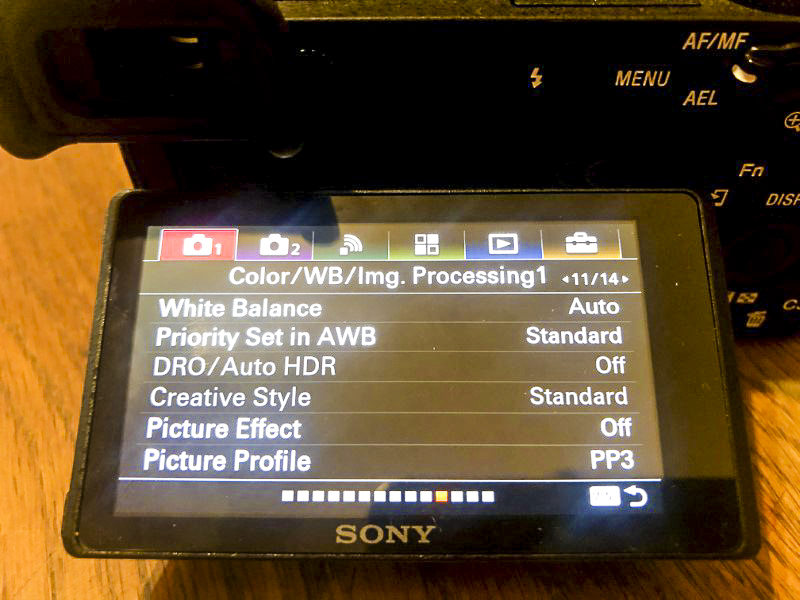
Picking up any new camera can be frustrating, especially when adjusting to new button layouts and menus. The Sony a6500 has done well to be pretty intuitive and has various customizable options to help you.
The menu of the Sony a6500 is quite easy to navigate, with color-coded tabs. There are two camera menus: a wireless menu, an application menu, a playback menu, and a setup menu. Most of the adjustments you will make are on the red camera one menu and the purple camera two menus.
The camera has plenty of customizable buttons, including three standalone buttons, the center button on the wheel, and the right and down buttons on the dial. Under the purple camera, there are two tabs of the menu. On page 8, you can assign functions to these buttons.
A lot of how this camera functions can be set up specifically for your uses. If you notice you’re taking a lot of time switching between certain settings, assign a button as a shortcut.
The main changes I’ve made are to the C1 and C2 buttons on the camera’s top. To C2 I assigned focus mode, allowing me to quickly switch between autofocus and manual, and the C1 button is set for white balance.
On the settings dial on the top of the camera, you can switch between auto, aperture priority, shutter speed priority, fixed ISO, scene selection, panorama, and movie mode, as well as two customizable settings labeled 1 and 2.
For filmmakers, the three that are most usable are the manual setting and the customizable 1 and 2 settings.
When working on projects I try to shoot at 24fps when possible. Under the customizable 1 setting, I have my camera set to 24p, the shutter speed at 1/50, and the Cine2 picture profile with the Cinema gamma.
Under the 2 setting I have the camera set to slow motion for when I want to collect B-Roll and have the camera set to 60p with a 1/125 shutter speed.
Utilizing the customizable buttons and dials on the Sony a6500 will make your life much easier and has been one of my favorite features of this camera. Though by no means unique to the a6500, it is good to know this is an option.
Recommended Attachments
If you acquire a Sony a6500 and intend to use it primarily for video, there are some attachments you should strongly consider. To bolster the strengths of the camera and fight its weaknesses, below are some suggestions.
Like any camera, the onboard microphone is not useable. Buying a mic that can connect with the camera will be helpful for better audio quality.
You should check out our guide to budget-friendly on-camera microphones if you want a good microphone for easy running and gunning.
If you’re looking for a microphone for interviews that don’t capture as much of the surroundings, you should check our guide to budget-friendly lavalier microphones.
If you intend to use a separate audio device like the excellent Zoom H4nPro (which is a good idea to circumvent the preamps in the camera and get more channels for recording two persons at the same time), then be sure to slate or clap, to sync audio.
The next suggestion would be a cage for the camera. Not only does this increase the mounting options for the camera, but it also adds some weight and protects your camera. The added weight allows you to hold the camera a bit steadier and will make handheld shots smoother.
Next, I would suggest buying a quick-release plate. With a quick-release plate, you can quickly take the camera off a tripod and switch between handheld and locked-down set-ups. Which quick-release plate you should get, depends on your tripod and especially the (fluid) head of your tripod.
Look at our guide to the best video tripods, which don’t cost an arm and a leg. For example, the first one on the list from Manfrotto with the XPRO Fluid Head also includes a quick-release plate and is an excellent buy.
The APS-C sensor makes the Sony a6500 a small and portable camera, and moving quickly lets you play to this strength.
Conclusion
The Sony a6500 is a compact camera with a lot to offer. Though it came out over three years ago, this camera still holds up today and can produce a very professional-looking image.
Additionally, its features make it one of the best cameras among DSLRs and Mirrorless cameras for filmmaking.
Being able to shoot video in 4k, having a 5-axis image stabilizer, and offering various picture profiles make the a6500 extremely versatile and functional in most situations.
If you’re traveling or in the field, you can get away without having an external monitor and even shoot video without a tripod if needed.
Though a small APS-C camera, features such as the zebra warnings, focus peaking, and histogram let you achieve a lot.
Unfortunately, this isn’t a perfect camera, with some drawbacks. Though the APS-C sensor gives the Small a6500 a small form factor, it lacks some of the strengths of a full-frame camera.
For one, the ISO range isn’t as good as some full-frame cameras, such as the A7S. Once you hit an ISO of 6400 on the a6500, there will be some noticeable noise. However, the A7S is also approximately double the price of the a6500.
Full-frame cameras also tend to have a better dynamic range. Picture profiles such as S-Log2, S-Log3, and even Cine2 will help increase the amount of information the a6500 picks up, but it won’t beat a full-frame sensor.
Being an APS-C camera also means that there is a conversion for full-frame lenses, and finding wide-angle lenses can be difficult. With as 1.5x conversion, many wide-angle lenses will read as normal, and normal lenses telephoto for this camera.
However, with the APS-C sensor, you can also use Full-Frame lenses and Focal Reducers such as the Metabones Speedbooster, which vastly increases the number of lenses you can use on the camera.
The final con for the Sony a6500 is the 4k capabilities. Though it is a great option, the overheating caused by shooting in 4k and the rolling shutter can cause some serious issues. Indicative of this, I don’t have 4k set to either of my preset shooting settings.
That being said, rolling shutter tends to be a problem on full-frame sensors (if that’s what you’re comparing it to) due to the larger sensor size.
Also, the depth-of-field of a full-frame sensor is more shallow (at the same focal length), and can be harder to control, which isn’t always recommended for shooting film.
All said and done, I would still recommend this camera for independent filmmakers if it’s in their budget. The versatility of such a small camera makes it very useful for run-and-gun filmmaking and filmmakers who travel.
Have you used an a6500 before? And if so, what did you think? Let us know in the comments what features of this camera excite you the most. The Sony a6500 is going on four years old, though I expect I will continue to use it for the foreseeable future!


I’ve had the a6500 since day one but have never shot video on it. It’s been a great stills camera and has resulted in some photo awards. Since I no longer shoot video professionally and have sold off my video cameras, I’m planning on doing personal video on the Sony. I appreciate this article and some of the insights on the video aspects of the camera. The article has also sparked some interest in shooting more video when I travel. Thanks!
Hi David.
I’m glad you found it useful and inspirational. You don’t always need the latest and greatest to make great videos. And the a6500 is tried and tested beast.
Best of luck on your videography journey 🙂
Best, Jan
What program will open videos onto my laptop from the card from my Sony a6500?
Hi David.
Any video editor will do, actually. Check out the guide to the best free video editing software, if you don’t already have one.
Best, Jan
I completely agree with the review! I’ve been using the A6500 for a while now and it’s still an incredible camera for video. The autofocus is super smooth and the image quality is top-notch. I’ve been really impressed with how well it’s held up over time too. Great review, thanks for sharing!